The Rottweiler is a mastiff-type working dog with a short coat and a muscular build. They only come with a black and tan pattern, so their coat colors are limited.
Rottweiler Color Chart
An overview of Rottweiler colors.
| B/B E/E ky/ky at/at black-based tan point | |
| tan | 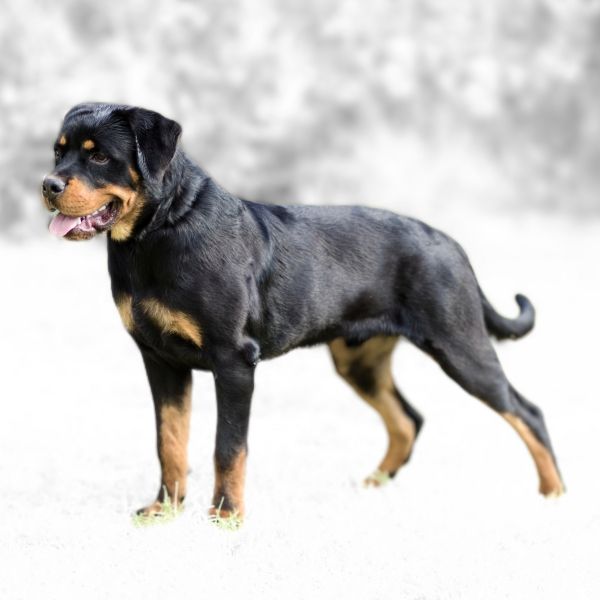 black & tan |
| rust |  black & rust |
| mahogany | 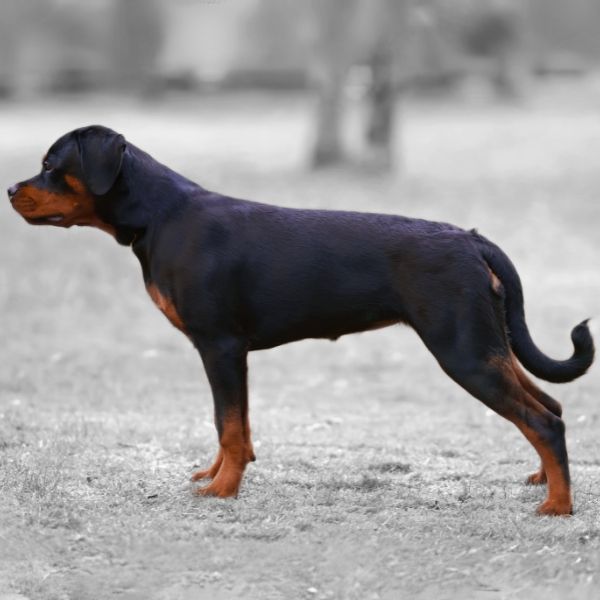 black & mahogany |
Rottweiler Coat Colors Overview
Different breed standard are usually similar in their general outline but can differ in details like coat color. Let’s see what the major kennel clubs have to say about the accepted Rottweiler colors[1-3]:
| AKC | FCI | KC | |
|---|---|---|---|
| Black & Tan | ✅ | ✅ | ✅ |
| Black & Rust | ✅ | (✅) | (✅) |
| Black & Mahogany | ✅ | (✅) | (✅) |
Brackets indicate color names that are not mentioned in the breed standard without excluding them.
Standard Rottweiler Coat Colors
All Rottweilers are fixed for a black-based tan point pattern (E/E ky/ky at/at).
This pattern is commonly called “black & tan“.
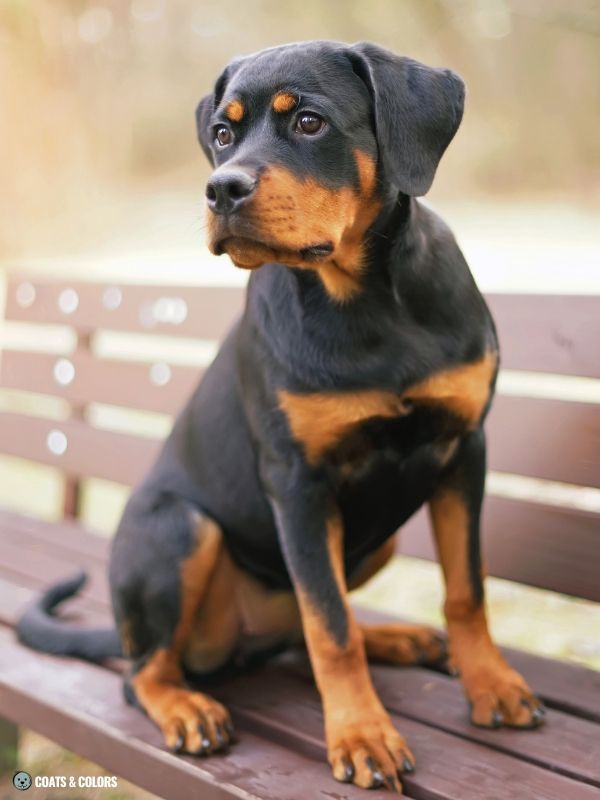
They are solid black with tan, rust, or mahogany markings. There are two types of pigment, the black coat gets its color from eumelanin, the reddish markings get their color from phaeomelanin.
The tan point coat is predominantly eumelanic but has distinct phaeomelanin markings. Dogs with this pattern can have a grayish or reddish undercoat although black undercoat seems to be preferred.
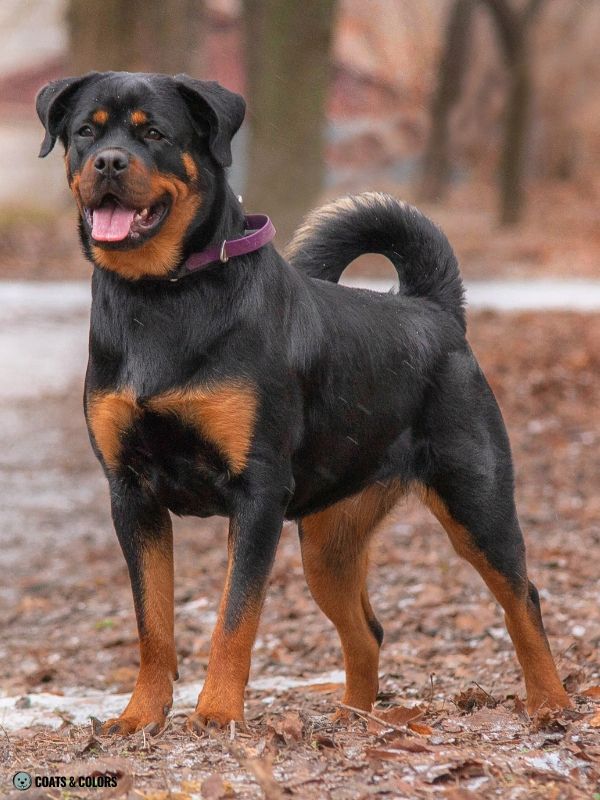
It’s quite normal for dogs to show some rust hairs intermingled in the black areas. But Rottweilers are bred for having clearly defined edges between their black coat and their tan markings.
Still, some dogs show very sooty markings with black “smut“.
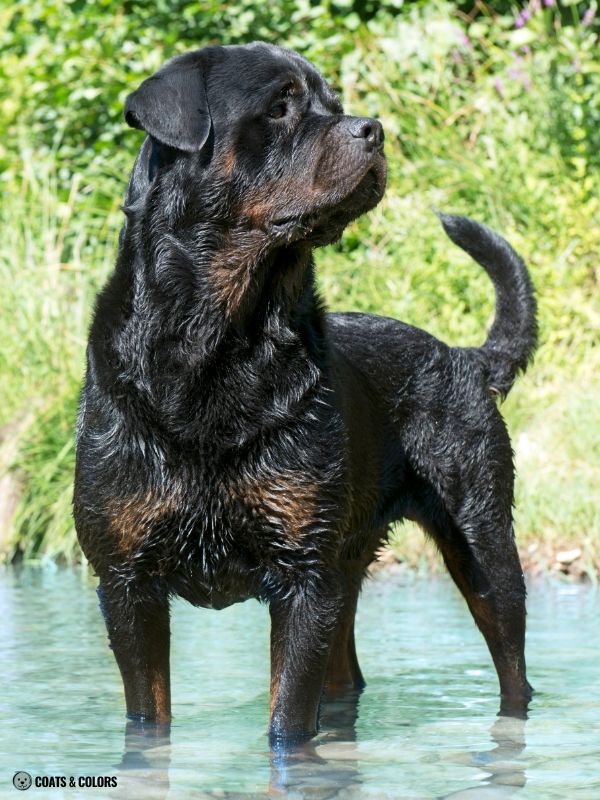
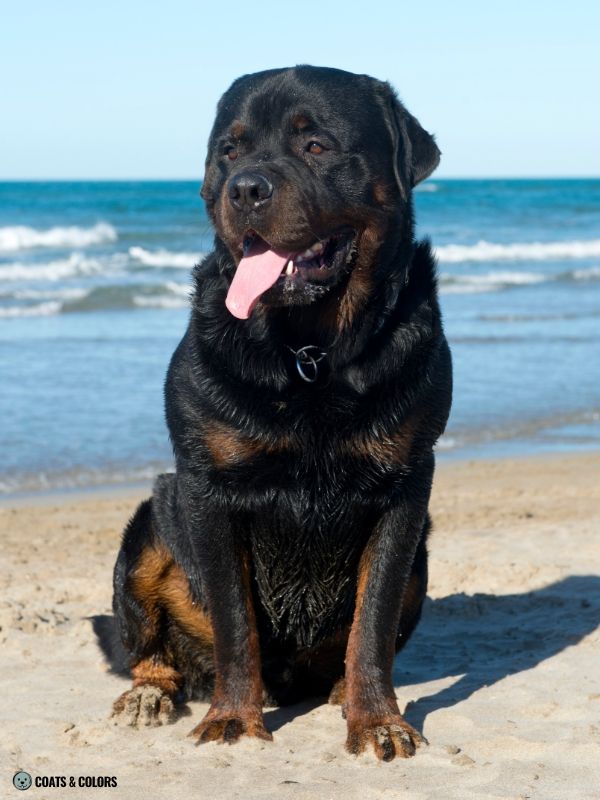
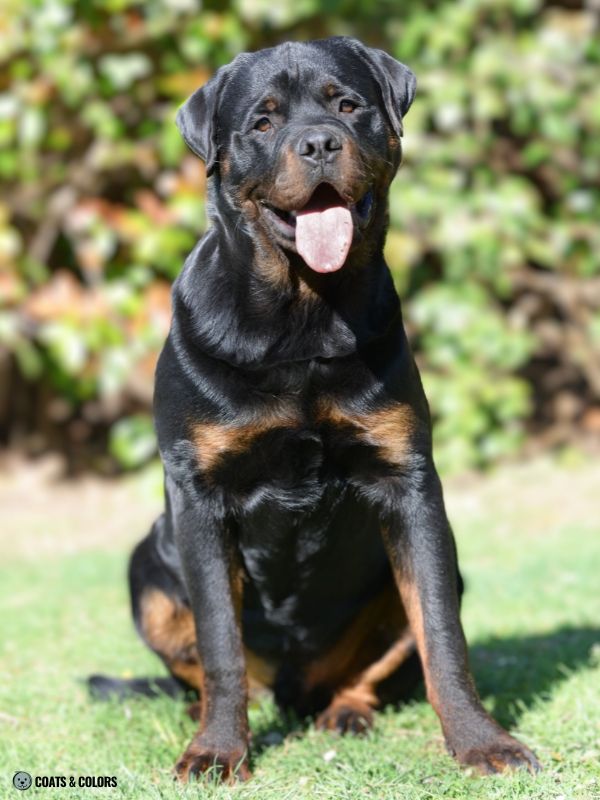
The intensity of their tan markings can vary from tan to rust to a deep red called mahogany. They are not supposed to have pale straw-colored markings, Rotties should have a rich color in their markings.
Only the AKC lists different color options, other clubs simply use “black & tan” for all shades of red pigment. As is usually the case with breed terms, there is no clear definition provided of where exactly the lines are drawn between nuances in red intensity such as “rust” or “mahogany” anyway.
The tan markings are always located in the same areas on the body. Not only in Rottweiler markings, you’ll find the same markings in basically all dogs that express a tan point pattern!
Rottweiler face markings include a tan spot above each eye.
They also have tan on the sides of the muzzle, cheeks, and throat.
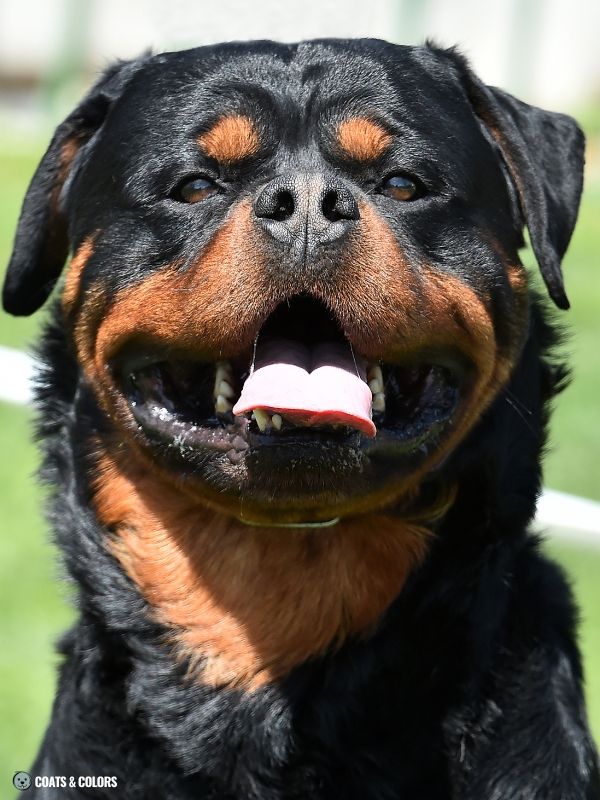
The tan pigment forms two triangular markings on the chest. The paws and lower legs as well as the inside of rear legs is covered in tan. Finally, they have a tan spot under the tail.
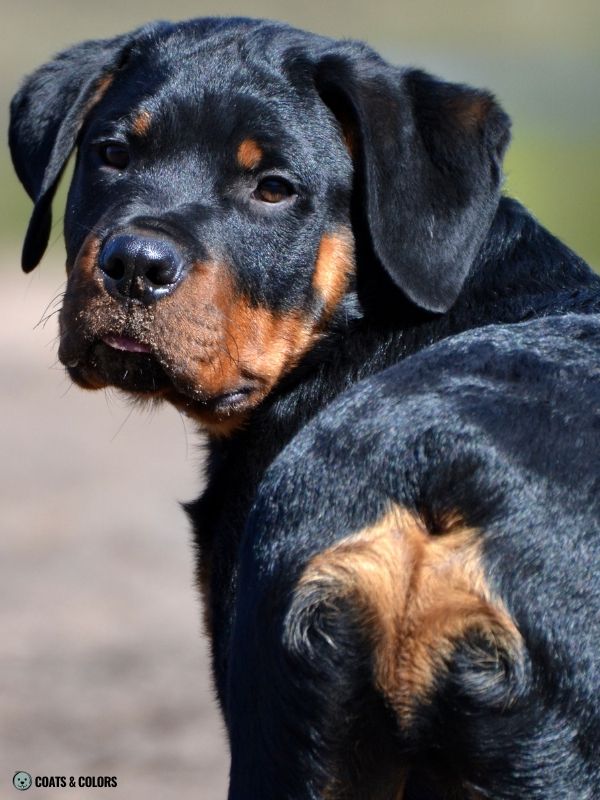
“Always black with rust to mahogany markings.“
AKC Breed Standard
“Black with clearly defined markings of a rich tan on the cheeks, muzzle, throat, chest and legs, as well as over both eyes and under the base of the tail.”
FCI Breed Standard
Black & Tan Rottweiler
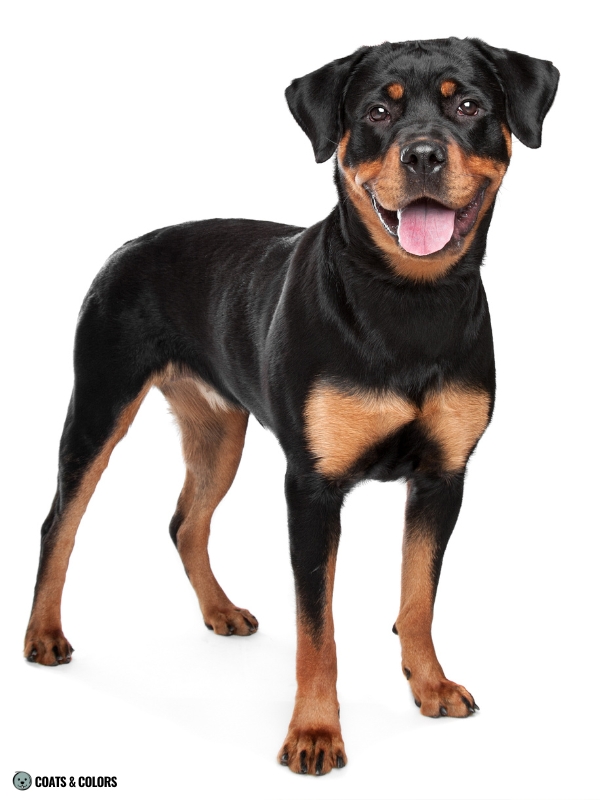
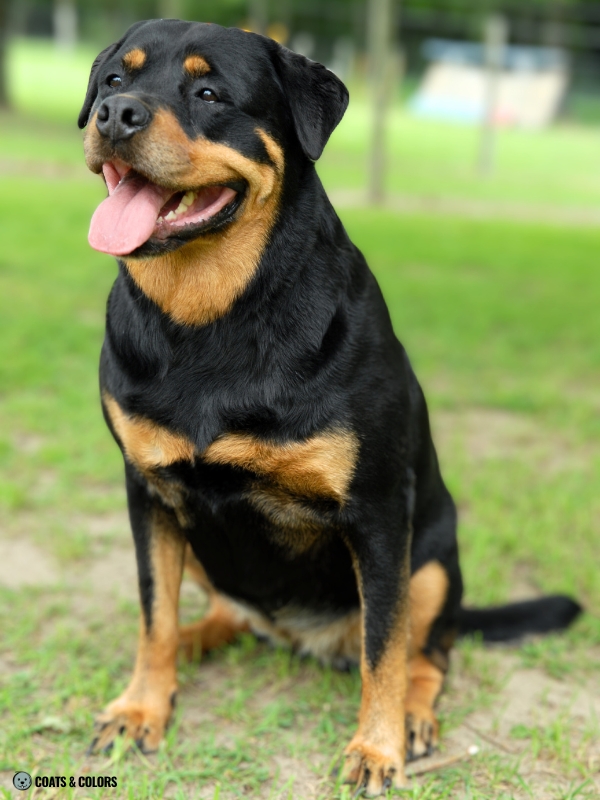
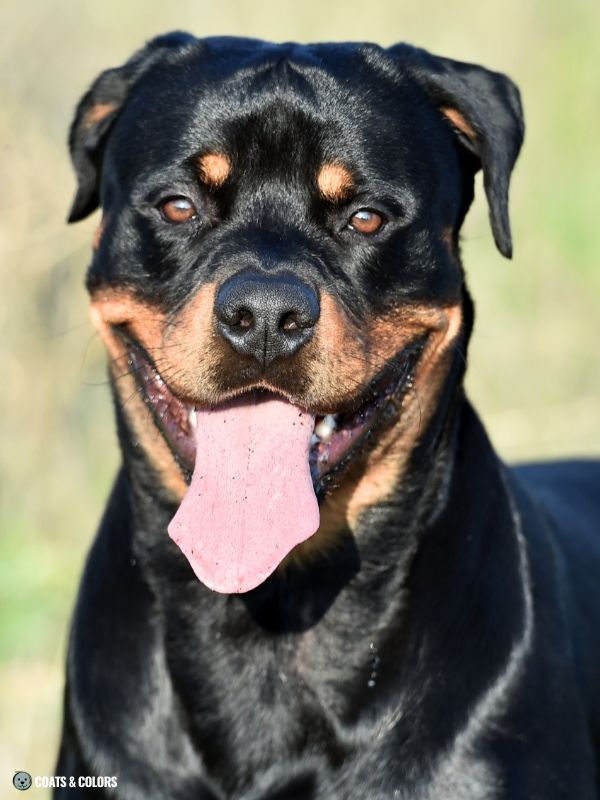
The FCI calls all Rottweilers “black and tan”.
The AKC, however, uses “black and tan” only for dogs that truly have tan-colored phaeomelanin markings with a lighter orange-yellowish shade.
Black & Rust Rottweiler
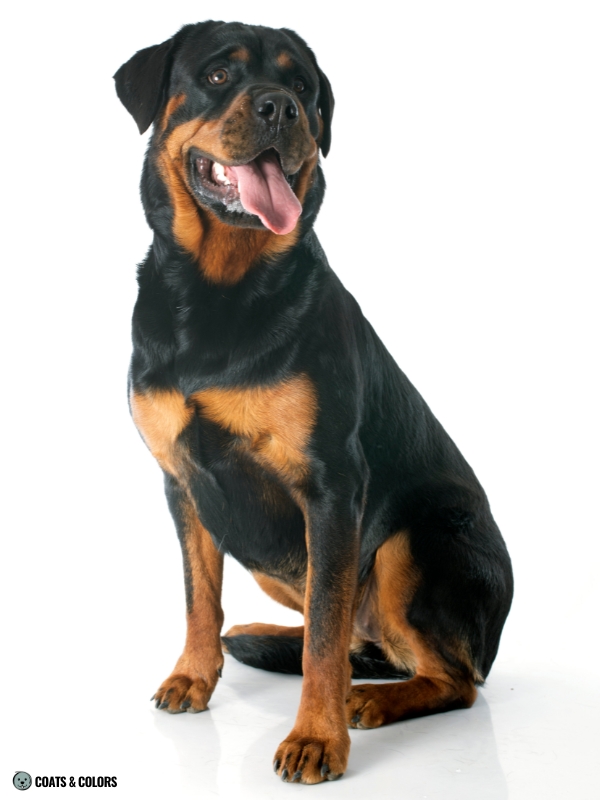
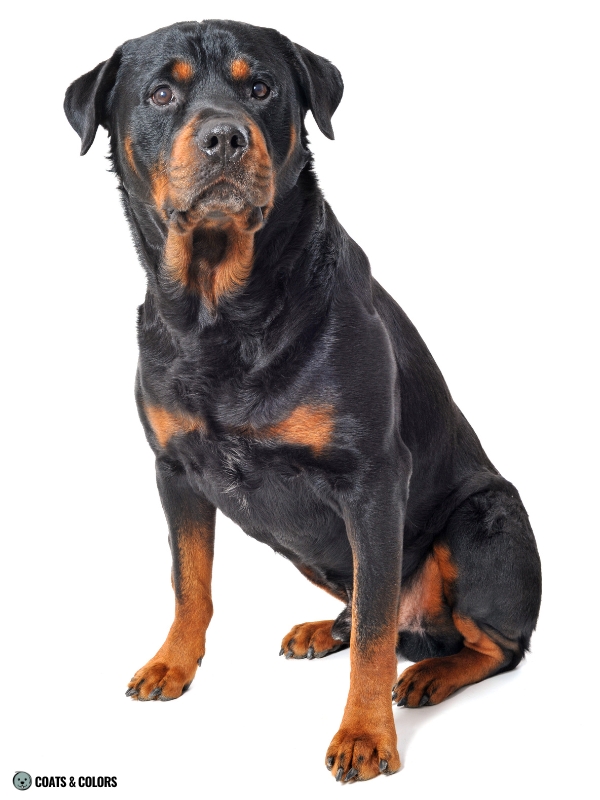
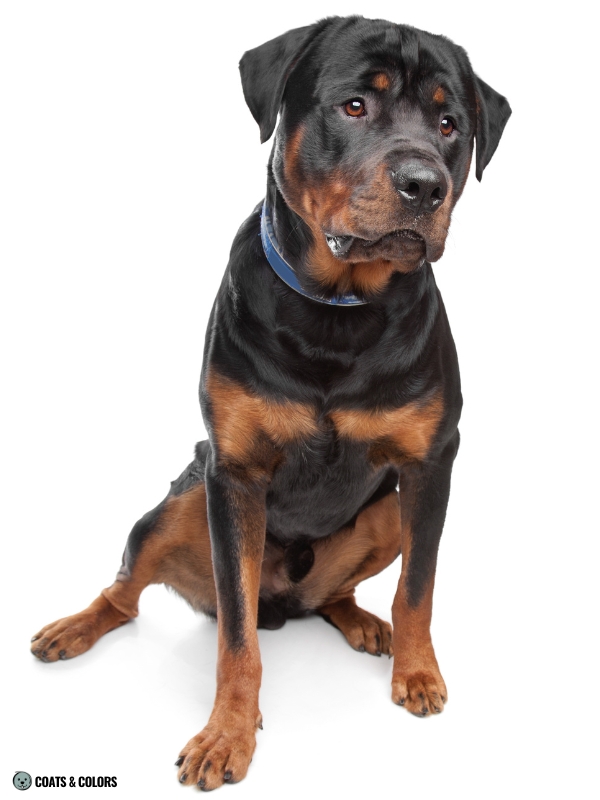
This is an AKC breed term that refers to an intermediate red intensity between tan and mahogany.
Black & Mahoganym Rottweiler
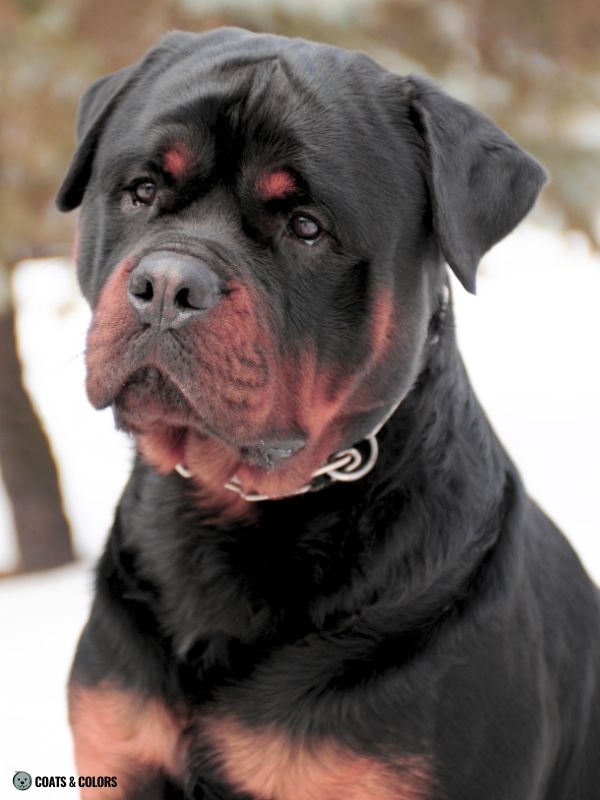
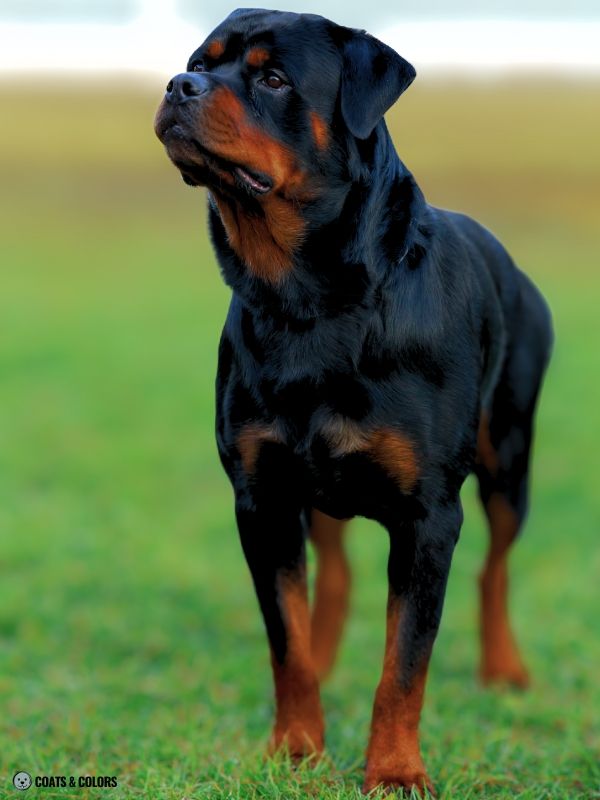
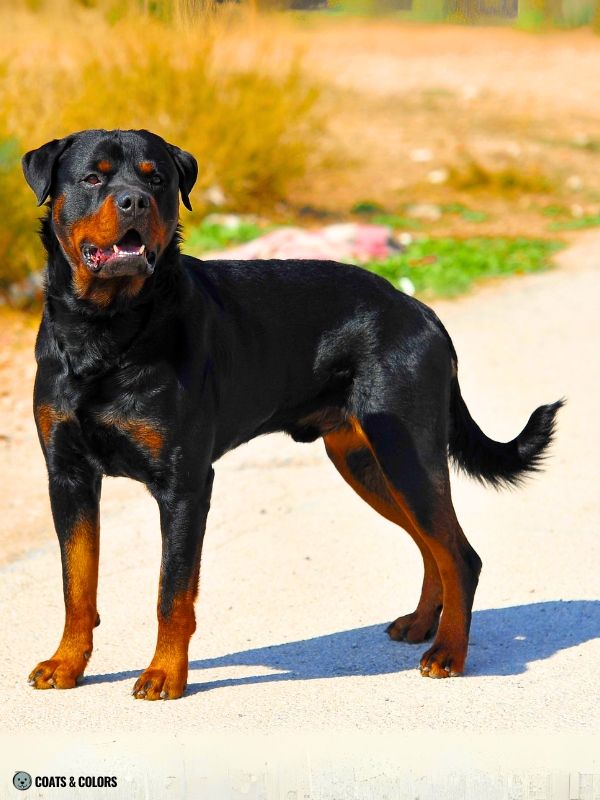
Another AKC breed term for Rotties with an intense deep red color in their points.
Rottweiler Coat Color Genetics
These alleles occur in Rottweilers:
| E-LOCUS | Em = melanistic mask E = normal pattern e = recessive red |
| K-LOCUS | ky = wild type, enables normal pattern |
| A-LOCUS | at = tan points (ASIPBB) |
| RED INTENSITY | tan rust mahogany |
| B-LOCUS | B = black eumelanin b = brown eumelanin |
| D-LOCUS | D = normal eumelanin d = diluted eumelanin |
| S-LOCUS | S = solid sP = white markings |
| M-LOCUS | m = non-merle |
Rottweiler Patterns
The A locus, K locus and E locus control all basic pigment distribution patterns.
They tell pigment cells when and where to make either eumelanin or phaeomelanin.
A Locus
Rottweilers are fixed for a tan point pattern (at/at).
They breed for moderately sized points with crisp edges.

The preferred color is dark rust to mahogany.
The FCI standard lists “markings which are too spread out” as a fault. The AKC says that markings should “not exceed ten percent of body color“. However, there is some natural variation in the size of tan points.

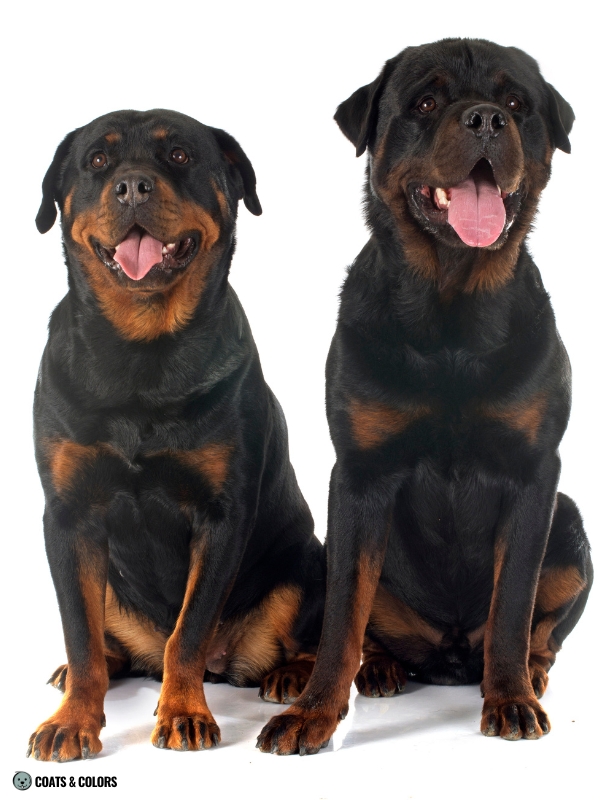
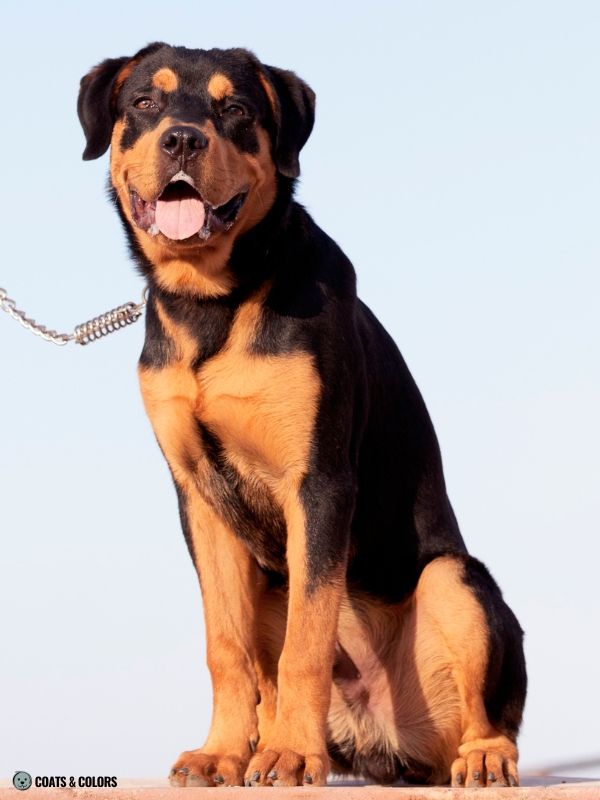
K Locus
To be able to express their tan point pattern, all Rottweilers have to be ky/ky.
E Locus
Most Rotties are homozygous for the wild type variant (E/E) at the E locus.
A few dogs may have a melanistic mask (Em/-) which may cover some of the tan on their face or chest or cause face markings to look “sooty” or “smutty“. This is not a standard coat color, of course.
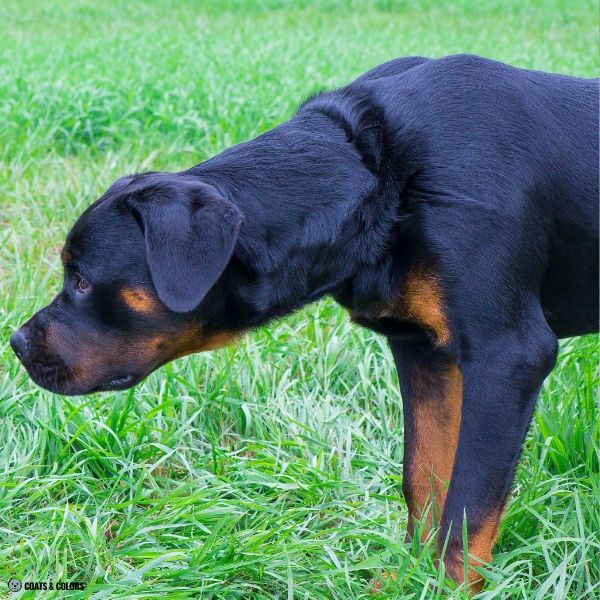
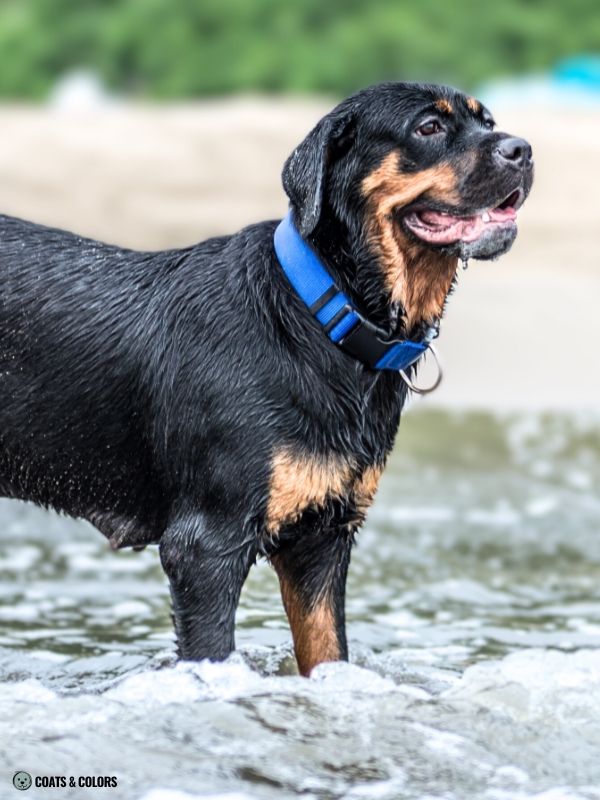
Eumelanin Colors
Rottweilers have black eumelanin (B/B). The black pigment is visible in their coat and also gives them their black nose, eye rims, lips, whiskers, and toenails.
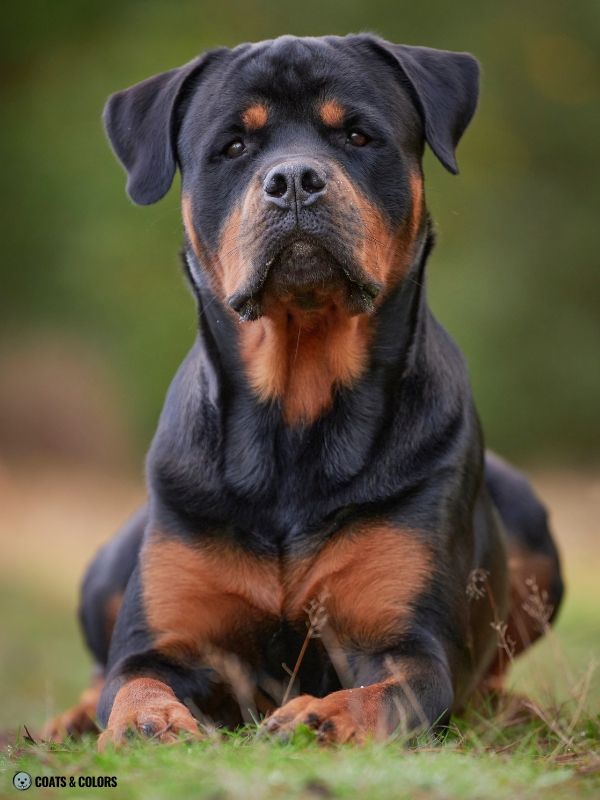
A very, very small number of Rotties may carry a recessive b variant.
“[…] black with clearly defined rust markings.“
AKC Breed Standard
“[…] black coated […]“
FCI Breed Standard
Phaeomelanin Intensity
The phaeomelanin intensity varies from a bright yellowish orange (tan) to a more intense reddish orange (rust) which can darken into a deep red color (mahogany).
Markings should be very well defined with crisp edges.
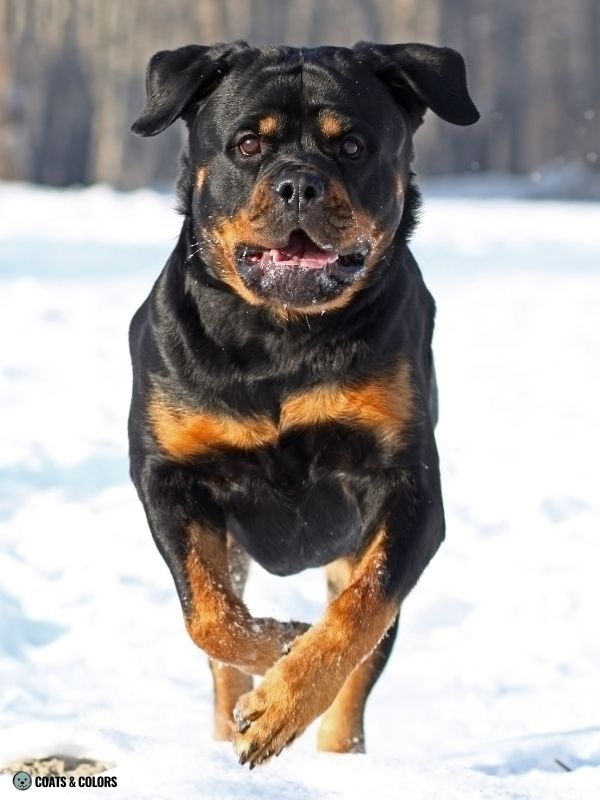
The AKC goes into great detail to describe the correct placement of markings on an ideal Rottweiler.
Rottie markings are located where they always are in this kind of pattern:
Above the eyes, under the tail, on the lower legs and paws as well as on the inside of the rear legs. Face markings extend from the throat to the cheeks from where they form a strip around each side of muzzle while leaving a black nose bar. Chest markings form two triangular shapes.
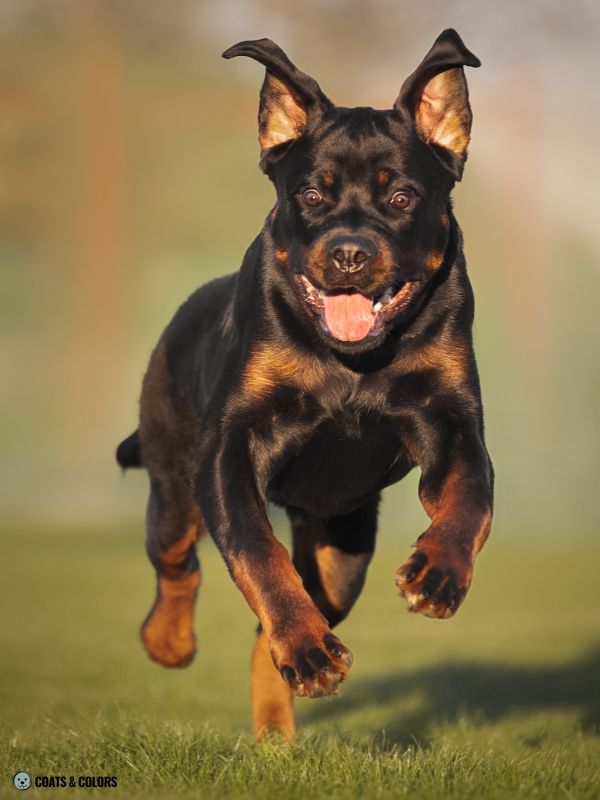
The AKC also specifically mentions “toe pencilling” and “tar heels” as breed traits.
“Serious Faults – Straw-colored, excessive, insufficient or sooty markings […]“
AKC Breed Standard
“[…] clearly defined rich tan markings […]“
FCI Breed Standard
White Spotting
Rotties are not supposed to have white.
Still, a Rottweiler with white markings can happen due to residual white.
This happens when not all pigment cells complete their migration during early development. The extent of residual white can vary, it often causes just a small white patch on the chest or toes.
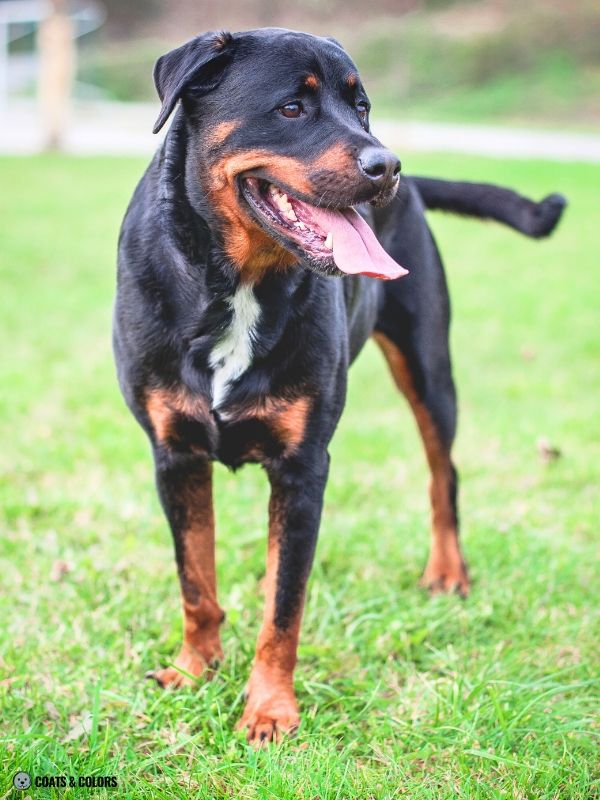
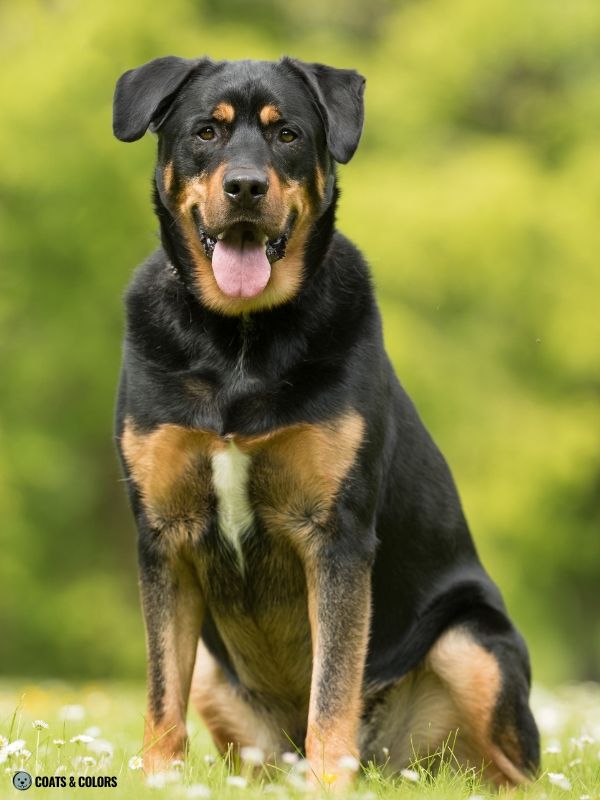
“Serious Faults – […] white marking any place on dog”
AKC Breed Standard
“Disqualyfing faults: […] White markings.”
FCI Breed Standard
Coat Color Genotypes
Translating Rottie color terms is easy:
| Color Term | Pattern |
|---|---|
| Black + Tan Black + Rust Black + Mahogany | B/B D/D E/E ky/ky at/at black-based tan point + varying phaeomelanin intensity |
Rottweiler Eye Colors
Rottweilers can only produce black eumelanin (B/B D/D).
This causes them to have brown eyes.

The German ADRK uses an eye color chart to determine eye color in breeding dogs.
This chart shows a range of eye colors from black to various shades of brown to yellow.
Colors lighter than medium brown are undesirable and thought to take away from the expression of the dog. The FCI considers yellow eyes a disqualifying fault.
“The desired color is a uniform dark brown. Serious Faults – Yellow (bird of prey) eyes […]”
AKC Breed Standard
“Eyes: […] dark brown in colour.”
FCI Breed Standard
Rottweiler Nose Colors
All dogs with a black and tan coat color have a black nose.
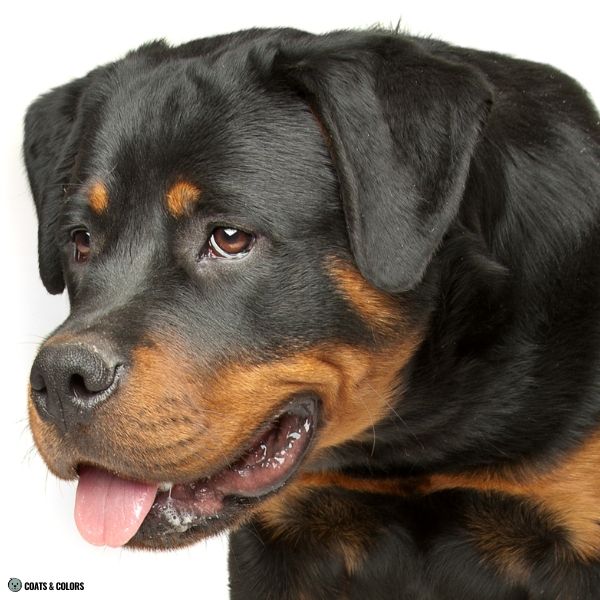
“Nose […] always black.“
AKC Breed Standard
“Nose: […] always black.”
FCI Breed Standard
Vitiligo In Rottweilers
Vitiligo is thought to be an auto-immune condition that affects pigmentation but ius otherwise harmless. Not a whole lot is know about why it happens but it’s believed to be hereditary.
Affected dogs typically start to lose black pigment from the face backward. However, vitiligo can extend to all black areas and can also (but rarely does) affect the tan areas.
Vitiligo can also remove skin pigmentation which can cause pink or spotted patches.
Rottweiler Mismarks and Fancy Colors
Non-standard colors occur in any dog breed.
In the beginning of the Rottweiler breed, there were more patterns than black and tan.
Solid red or blonde Rottweilers had a recessive red (e/e) or they were fawn from having a sable pattern (ky/ky Ay/-). Other dogs were “wolf sable” or agouti (ky/ky aw/-).

All patterns could show brindle (kbr/-) or white markings.
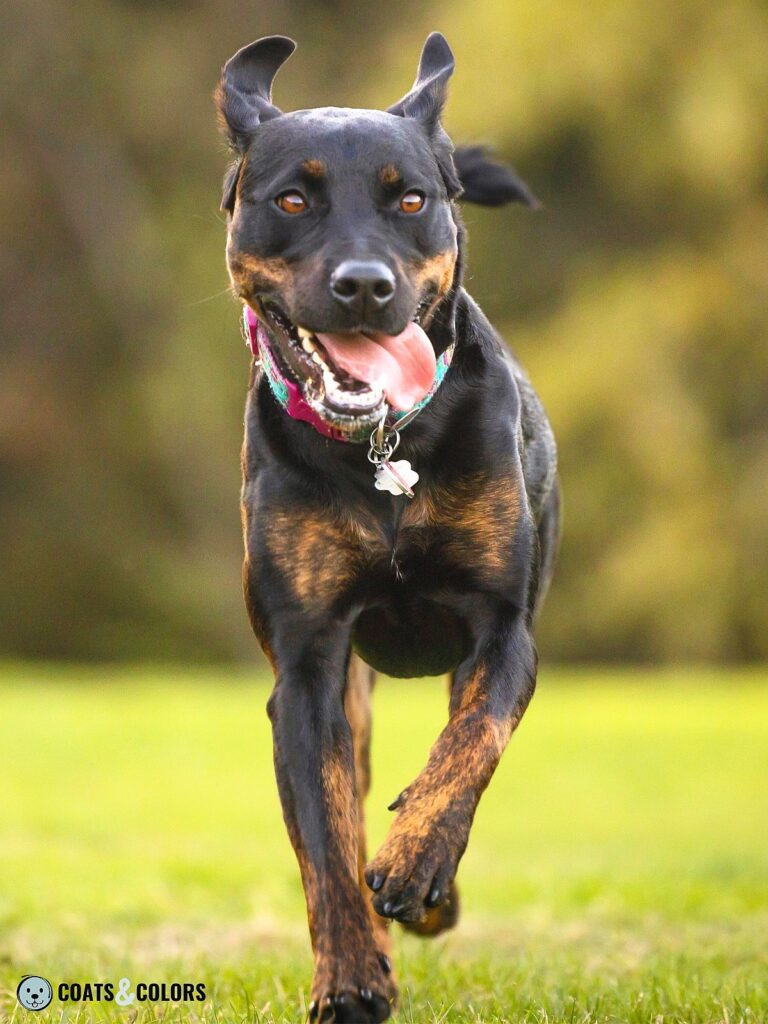
However, there aren’t many off-colors in Rotties today.
All of the above traits have been long bred out of the purebred population.
But backyard breeders sell lots of fancy colors they produce on purpose.
It’s not that hard to introduce off-colors and then breed back to Rotties to get a puppy that resembles a purebred dog but has a new color. Are these dogs purebred? Of course not.
Some dogs sold as Rottweilers have a brown and tan or blue and tan coat. Both chocolate brown eumelanin (b/b), as well as diluted eumelanin (d/d), happen due to recessive alleles.
Recessive alleles are not expressed in carriers (such as B/b).
But accidentally breeding two carriers (B/b x B/b) can result in say a “red“-nose Rottweiler puppy that got the recessive variant from both its parents (b/b) thus expressing it in its coat.
Some breeders sell white Rottweilers. This includes albino dogs as well as dogs with extended piebald (sP/sP). Adding white markings into the mix can also cause tricolor Rotties.
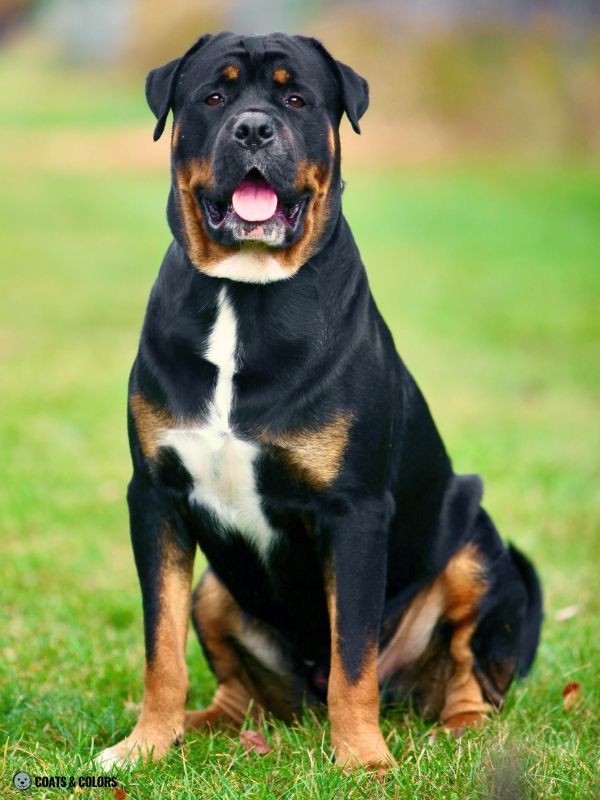
All-black Rottweilers or “gray” Rottweilers can get their solid coat from either being recessive black (ky/ky a/a) but are most likely dominant black (KB/-). One copy of the KB variant is enough to remove any tan from a pattern. And a “black and tan” dog without tan is … solid black (or gray if it also is d/d).
Blue-eyed Rottweilers don’t happen in purebred dogs either.
There is only one thing we know of that can cause blue eyes in the absence of merle (and Rotties were never merle) or face white. And that is the ALX4 variant common in Siberian Huskies.
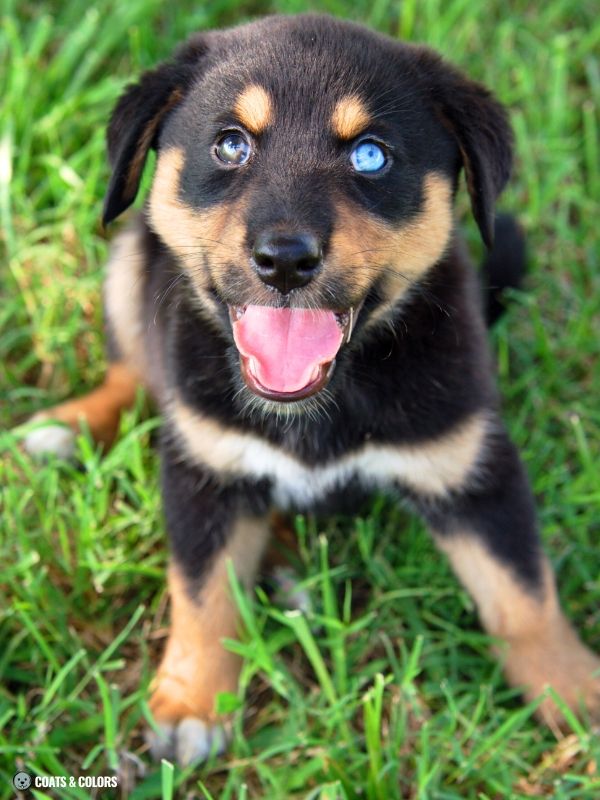
You see, about all mismarks in Rotties happen due to alleles that are not part of today’s purebred Rottie gene pool. Truly recessive variants that can be carried (such as e, a, b, or d) are super rare.
It is highly unlikely that there are still many carriers in times of genetic testing and after decades of breeding for only a black and tan pattern. People who advertise off-colored Rotties have most likely introduced these old-new traits on purpose through outcrossing…
“Disqualifications: […] Any base color other than black; absence of all markings.”
AKC Breed Standard
“Disqualifying faults: […] Dogs which do not show the typical Rottweiler colouring of black with tan markings. White markings.”
FCI Breed Standard
Rottweiler Coat Types
Rottweilers are double-coated with short body hair and some undercoat. The undercoat can be black or it can show some gray or tan which is normal for black and tan dogs.

“Outer coat is straight, coarse, dense, of medium length and lying flat. Undercoat should be present on neck and thighs, but the amount is influenced by climatic conditions.”
AKC Breed Standard
“The coat consists of a top coat and an undercoat. The top coat is of medium length, coarse, dense and flat.”
FCI Breed Standard
Other Coat Types in Rottweilers
Some less common alleles in this breed can produce a non-standard coat type[4]:
Some Rotties are long coat carriers and can produce long-haired puppies when bred to another carrier. A very small number of Rottweilers carry a curly variant which may cause wavy coat in long-haired dogs.
Another faulty coat type is seen in bearded Rotties that express (weak) furnishings.
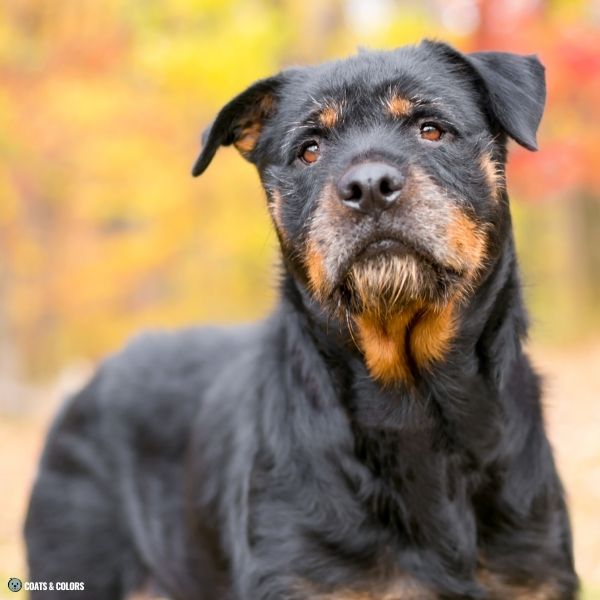
“Serious Faults – Open, excessively short, or curly coat; total lack of undercoat […] Disqualification – Long coat.”
AKC Breed Standard
“Disqualifying faults: […] Definitely long or wavy coat.”
FCI Breed Standard
Learn More
Links
[1] American Kennel Club (AKC): Official Standard of the Rottweiler (pdf)
[2] Fédération Cynologique Internationale (FCI): Rottweiler Breed Standard
[3] The Kennel Club (KC): Rottweiler Breed Standard
[4] Dreger et al. (2019). True Colors: Commercially-acquired morphological genotypes reveal hidden allele variation among dog breeds, informing both trait ancestry and breed potential. PLoS ONE 14(10): e0223995. https://doi.org/10.1371/journal.pone.0223995
[5] Allgemeiner Deutscher Rottweiler-Klub e.V.
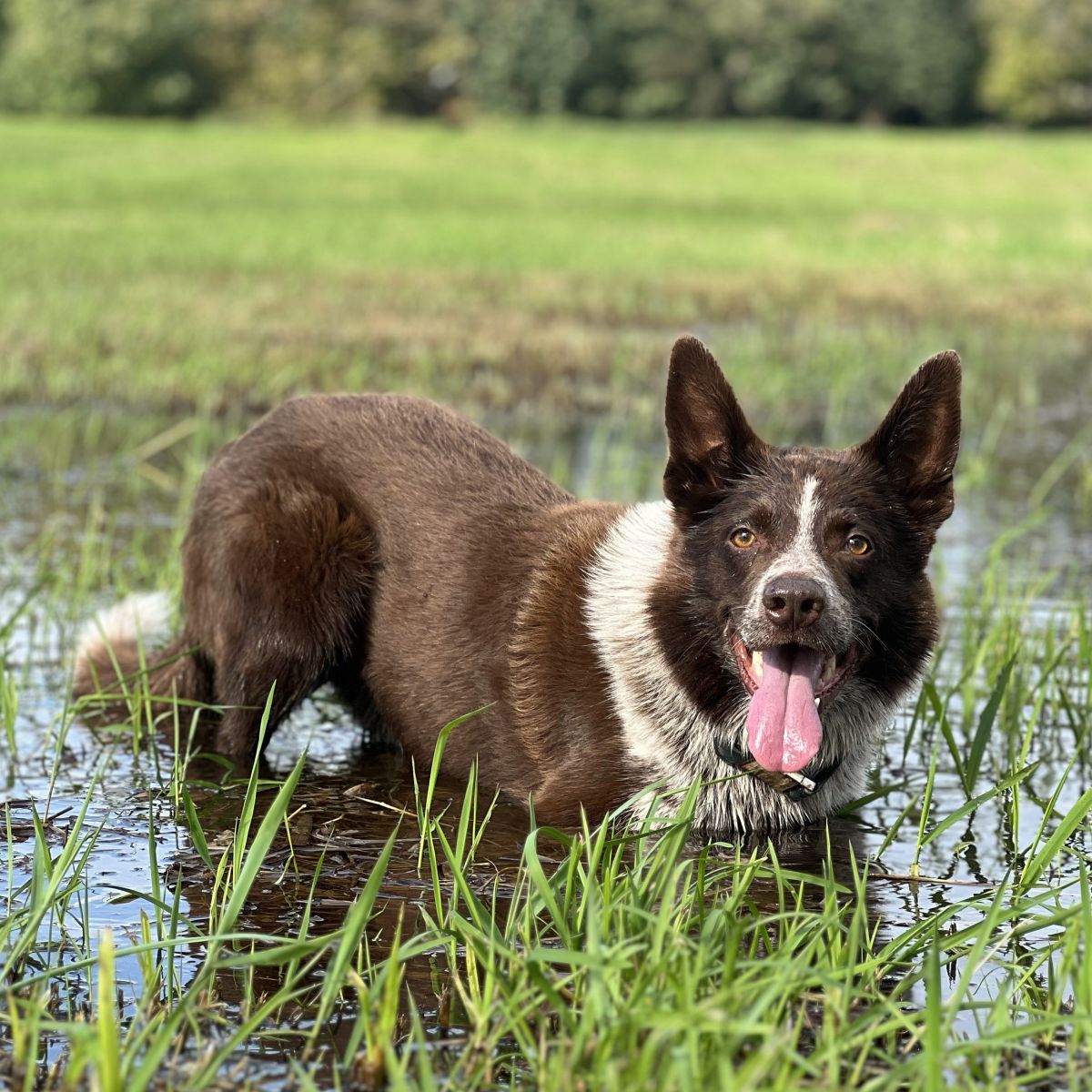
Hi! I’m Steffi. I am a biologist and a big time dog nerd. You are curious about coat color genetics? You’ve come to the right place! Read more.

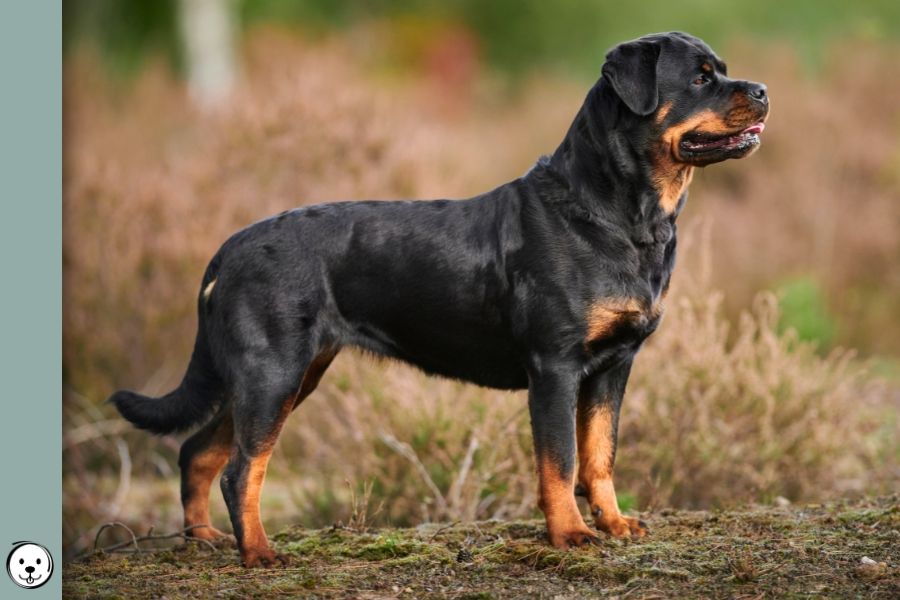
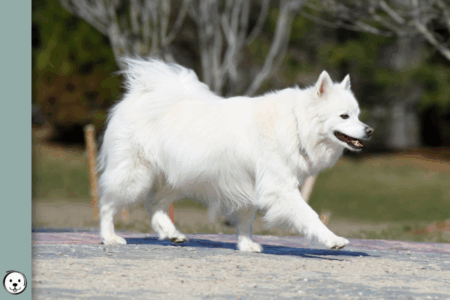

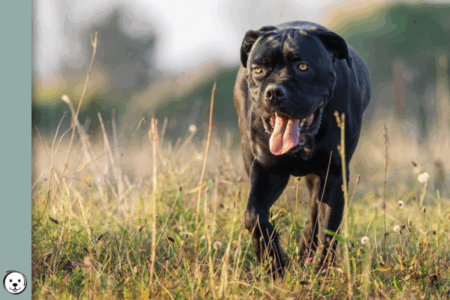
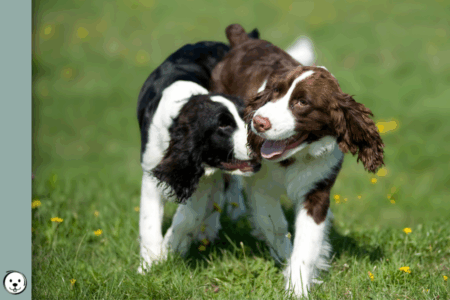
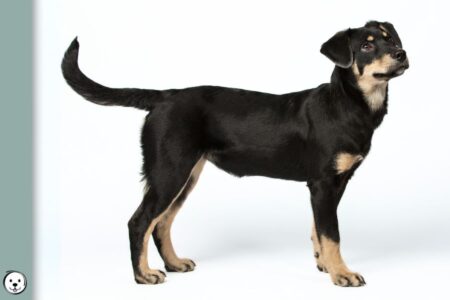
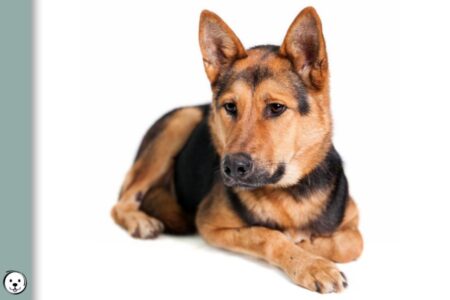
1 thought on “Rottweiler Coat Colors”
Comments are closed.